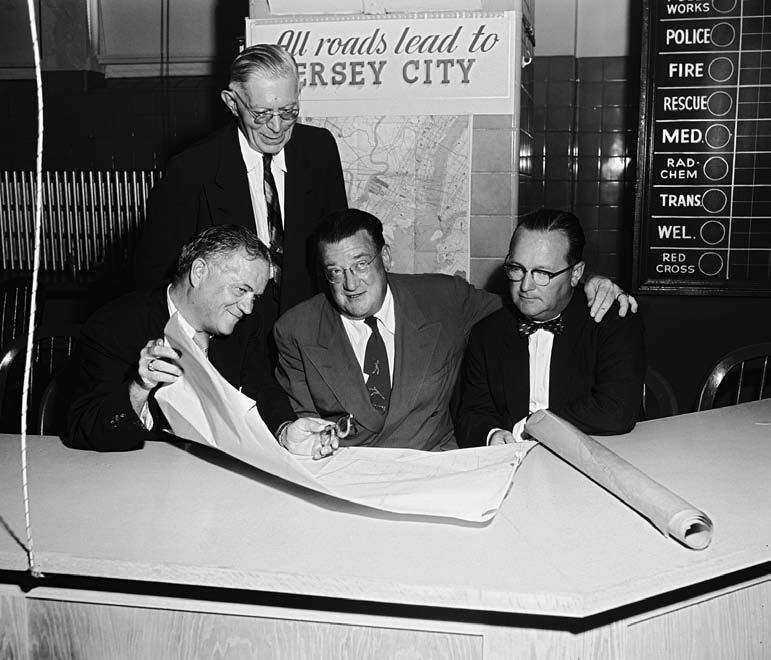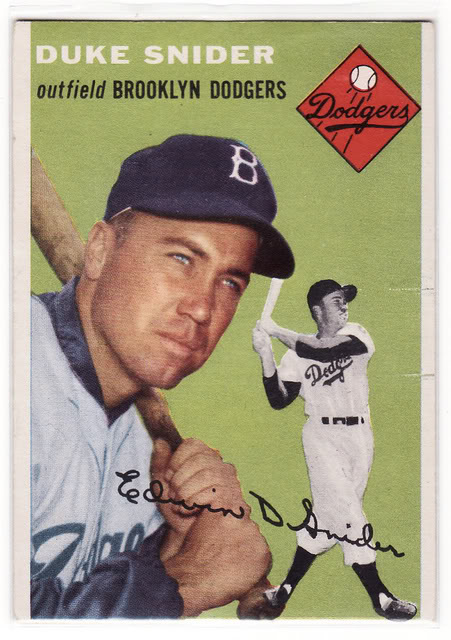July 25, 1956: Dodgers win on Snider walkoff home run in Jersey City
 Major-league baseball came to Jersey City, New Jersey, for the 1956 and 1957 seasons. The ongoing saga of the mid-1950s determining the future of baseball in Brooklyn now included New Jersey. Over these two seasons, the Dodgers played 15 home games at Roosevelt Stadium, one against each National League team each season, and two against the Phillies in 1957.
Major-league baseball came to Jersey City, New Jersey, for the 1956 and 1957 seasons. The ongoing saga of the mid-1950s determining the future of baseball in Brooklyn now included New Jersey. Over these two seasons, the Dodgers played 15 home games at Roosevelt Stadium, one against each National League team each season, and two against the Phillies in 1957.
John Burbridge’s Baseball Research Journal article “The Brooklyn Dodgers in Jersey City” discusses their home-away-from-home and its context in much detail.1 The irony is apparent in his introduction as the Dodgers win Game Seven of the 1955 World Series. “This is next year! They have won the elusive World Series for the first time. The borough celebrates, and the future appears rosy. It turns out, however, that this is actually the beginning of the end.” Burbridge speculates on owner Walter O’Malley’s unclear motives for playing these games in New Jersey. In the end, only the outcome is clear: the Dodgers’ move to a new home in Los Angeles to begin the 1958 season.
In 1956 this home wasn’t really home. Booing the Dodgers, individual players and opponents alike became commonplace.2 For the July 25, 1956, game, the New York Times reported such sentiment as “in the perverse fashion of Jersey City fans.”3
None of the Dodgers’ games at Roosevelt Stadium is as well-known and remembered as the minor-league game played there 10 years earlier. Serving as the home of the Jersey City Giants, Roosevelt Stadium hosted the Montreal Royals on April 18, 1946, to open the Triple-A International League season. Historic as it was, Jackie Robinson also considered this opening game of the 1946 International League season to be inspiring. It was his first game since being signed by Dodgers general manager Branch Rickey. “It was a major game and Clay Hopper had gambled on me by letting me hold down second base. … My big moment came in our half of the third when with two men on base, I swung and connected. It felt so good I could tell it was a beauty. The ball flew 340 feet over the left field fence. I had delivered my first home run in organized baseball.”4 The Montreal Royals trounced the Jersey City Giants, 14-1. Robinson went 4-for-5, with four runs scored, that home run, four RBIs, and two stolen bases.
On this Wednesday night in July 1956, the pitching matchup promised to be a good one for the capacity crowd of 23,454. Don Newcombe led the third-place Dodgers with 13 victories in 18 decisions and had already beaten every National League team except Cincinnati. Brooks Lawrence led the second-place Redlegs with victories in 14 of 15 decisions.
Hits off each pitcher were scarce throughout the evening and, said the New York Times,“aside from the well-spaced gophers they threw, Newcombe and Lawrence dominated the contest.”5 The Redlegs broke through first with two outs in the third inning when rookie Frank Robinson hit a solo home run, his 22nd of the season.6 To that point, Robinson had the only other hit off Newcombe, a groundball single to center field in the first inning. In fact, Newcombe spaced out just three singles for the remainder of the game, in the fourth, eighth, and ninth innings – two by Ted Kluszewski and one by Lawrence himself.
 In the fourth inning the Dodgers got back even when Carl Furillo hit a solo home run off Lawrence, his 12th of the season. That hit extended Furillo’s hitting streak to 18 games, matching teammate Duke Snider for the longest in the National League to that point in the season.
In the fourth inning the Dodgers got back even when Carl Furillo hit a solo home run off Lawrence, his 12th of the season. That hit extended Furillo’s hitting streak to 18 games, matching teammate Duke Snider for the longest in the National League to that point in the season.
Cincinnati had only one good scoring opportunity for the balance of the game. Lawrence hit a line drive single to centerfield with one out in the eighth inning, and Johnny Temple sacrificed him to second base, but Newcombe got Frank Robinson on a swinging strikeout, the last of his nine for the game. Lawrence, on the other hand, walked four during the game, but was the beneficiary of three double plays with shortstop Roy McMillan serving as the middleman on each.
The drama was left for the bottom of the ninth inning. With one out and a 1-and-0 count, Duke Snider hit a solo home run over the 411-foot center-field wall to make Don Newcombe (14-5) the winner and Brooks Lawrence (14-2) the walk-off loser.7 The walk-off home run was one of eight that Snider hit over his 18-year major-league career. For Newcombe, while pitching one of the 18 complete games he would throw in 1956, it was also a perfect night at the plate with a single and two walks. The win enabled the third-place Dodgers (50-39) to move to within 1½ games of second-place Cincinnati and six games behind the league-leading Milwaukee Braves.
For both Newcombe and Snider, their personal performances were a sign of good things ahead. Newcombe led the National League in 1956 with 27 victories and won the NL Most Valuable Player Award as well as the initial Cy Young Award; Snider led the NL with 43 home runs.8 Both were key contributors as the Dodgers edged the Braves by one game for the National League pennant, their last one in Brooklyn.
Author’s note
I attended this game with my father, who taught me to be a Dodgers fan. It was our only visit to Roosevelt Stadium, but it well complemented our joyful tradition of attending Dodgers-Giants games in the 1950s at Ebbets Field and the Polo Grounds. I got hooked when my Dad took this 8-year-old to Ebbets Field on June 3, 1951, for my first major-league game. The Dodgers swept the Chicago Cubs in a doubleheader and, of course, Don Newcombe pitched a complete-game victory, 8-3, in the first game.
Sources
Baseball-Almanac.com
Baseball-Reference.com
Retrosheet.org
Notes
1 John Burbridge, “The Brooklyn Dodgers in Jersey City,” Baseball Research Journal 39 (Summer 2010), sabr.org/research/brooklyn-dodgers-jersey-city.
2 Michael Shapiro,The Last Good Season (New York: Broadway Books, 2003), 96.
3 Joseph M. Sheehan, “Snider Hit in 9th Gains 2-1 Verdict; Dodgers’ Star Clouts No. 24 After Furillo Gets Homer Against Redlegs in 4th, Spectators Boo Dodgers, Rain Delays Start,” New York Times, July 26, 1956, 28.
4 Jackie Robinson, I Never Had It Made (New York: Putnam, 1972), 45-46.
5 Sheehan.
6 Frank Robinson won the 1956 NL Rookie of the Year Award, hitting 38 home runs and leading the league with 122 runs scored.
7 The term walk-off didn’t enter the baseball lexicon until 1988 as noted by Paul Dickson. “The term was coined by Oakland Athletics pitcher Dennis Eckersley for that lonely stroll from the mound after a pitcher gives up the winning run (Gannett News Service, July 30, 1988; Fred Shapiro).” Paul Dickson, The Dickson Baseball Dictionary, 3rd Edition (New York: W.W. Norton & Company, 2009), 919. Snider’s home run wasn’t even the most dramatic walk-off home run of July 25, 1956, in the National League. At Forbes Field in Pittsburgh, Roberto Clemente hit a walk-off inside-the-park grand slam to defeat the Chicago Cubs, 9-8. It remains as of the 2016 season the only such occurrence in major-league baseball. Jack Hernon, “Clemente’s Inside-Park Slam Nips Cubs, 9-8, Bucs Bounce Back After Losing Lead,” Pittsburgh Post-Gazette, July 26, 1956: 14.
8 Newcombe had won the NL Rookie of the Year Award in 1949. That trifecta of awards – Rookie, Cy Young, and MVP – was not to be accomplished again until Justin Verlander (Detroit Tigers) did so in 2011.
Additional Stats
Brooklyn Dodgers 2
Cincinnati Redlegs 1
Roosevelt Stadium
Jersey City, NJ
Box Score + PBP:
Corrections? Additions?
If you can help us improve this game story, contact us.

